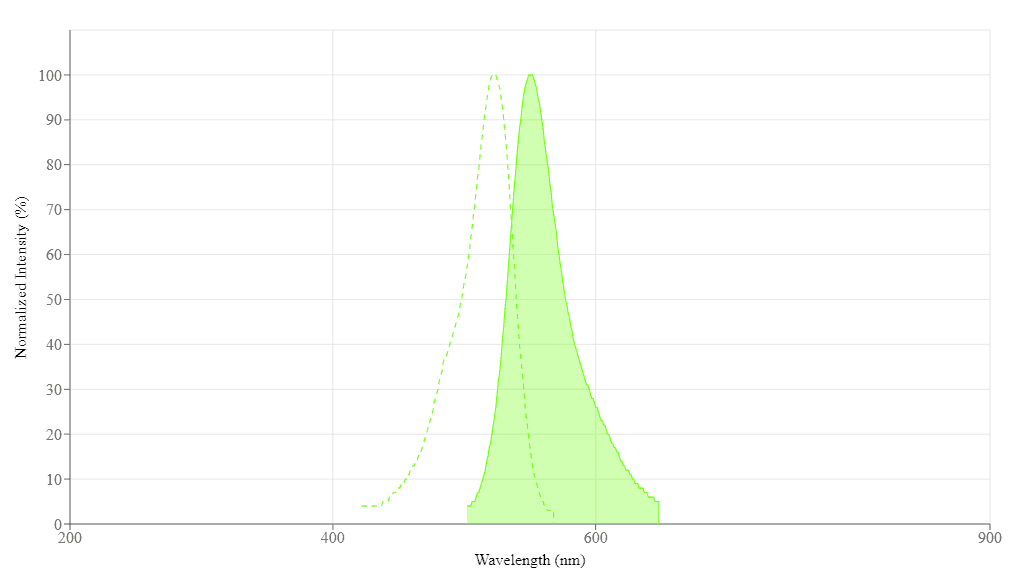Rhod-4™ amine
Ordering information
| Price | |
| Catalog Number | |
| Unit Size | |
| Quantity |
Additional ordering information
| Telephone | 1-800-990-8053 |
| Fax | 1-800-609-2943 |
| sales@aatbio.com | |
| International | See distributors |
| Bulk request | Inquire |
| Custom size | Inquire |
| Shipping | Standard overnight for United States, inquire for international |
Physical properties
| Molecular weight | 856.76 |
| Solvent | DMSO |
Spectral properties
| Excitation (nm) | 523 |
| Emission (nm) | 551 |
| Quantum yield | 0.11 |
Storage, safety and handling
| H-phrase | H303, H313, H333 |
| Hazard symbol | XN |
| Intended use | Research Use Only (RUO) |
| R-phrase | R20, R21, R22 |
| Storage | Freeze (< -15 °C); Minimize light exposure |
| UNSPSC | 12352200 |
Alternative formats
| Rhod-4™ maleimide |
| Rhod-4™ azide |
| Rhod-4™ alkyne |
Related products
| Rhod-4™, sodium salt |
| Rhod-4™, potassium salt |
| Overview |
See also: Rhodamines and Rhodamine Derivatives
Molecular weight 856.76 | Excitation (nm) 523 | Emission (nm) 551 | Quantum yield 0.11 |
Rhod-4™ amine is an excellent building block that can be readily used to prepare a calcium-sensitive bioconjugate for monitoring calcium change spatially for a specific target. It can be conjugated to carboxy-containing biomolecules via activated esters or EDC chemistry. Rhod-4™ is a fluorescent calcium indicator dye commonly used in cell biology and neuroscience research. It belongs to the family of rhodol-based calcium. Rhod-4™ is a high-affinity calcium indicator dye that exhibits changes in fluorescence intensity upon binding to calcium ions. When Rhod-4™ binds to calcium, its fluorescence intensity increases dramatically, allowing researchers to measure and monitor changes in calcium levels. Compared to the traditional Rhod-2, Rhod-4™ is a superior replacement. It is a valuable tool in calcium imaging research, enabling the detection and quantification of intracellular calcium dynamics. It's fluorescence properties and calcium binding specificity make it suitable for studying calcium signaling in various cell types and biological systems.
Calculators
Common stock solution preparation
Table 1. Volume of DMSO needed to reconstitute specific mass of Rhod-4™ amine to given concentration. Note that volume is only for preparing stock solution. Refer to sample experimental protocol for appropriate experimental/physiological buffers.
| 0.1 mg | 0.5 mg | 1 mg | 5 mg | 10 mg | |
| 1 mM | 116.719 µL | 583.594 µL | 1.167 mL | 5.836 mL | 11.672 mL |
| 5 mM | 23.344 µL | 116.719 µL | 233.438 µL | 1.167 mL | 2.334 mL |
| 10 mM | 11.672 µL | 58.359 µL | 116.719 µL | 583.594 µL | 1.167 mL |
Molarity calculator
Enter any two values (mass, volume, concentration) to calculate the third.
| Mass (Calculate) | Molecular weight | Volume (Calculate) | Concentration (Calculate) | Moles | ||||
| / | = | x | = |
Spectrum
Open in Advanced Spectrum Viewer


Spectral properties
| Excitation (nm) | 523 |
| Emission (nm) | 551 |
| Quantum yield | 0.11 |
Images
References
View all 6 references: Citation Explorer
Cigarette smoke extraxt influences intracellular calcium concentration in A549 cells.
Authors: Yoo, Y-M and Jung, E-M and Jeon, B-H and Tran, D N and Jeung, E-B
Journal: Journal of physiology and pharmacology : an official journal of the Polish Physiological Society (2020)
Authors: Yoo, Y-M and Jung, E-M and Jeon, B-H and Tran, D N and Jeung, E-B
Journal: Journal of physiology and pharmacology : an official journal of the Polish Physiological Society (2020)
Dexamethasone Treatment Increases the Intracellular Calcium Level Through TRPV6 in A549 Cells.
Authors: Jeon, Bo-Hui and Yoo, Yeong-Min and Jung, Eui-Man and Jeung, Eui-Bae
Journal: International journal of molecular sciences (2020)
Authors: Jeon, Bo-Hui and Yoo, Yeong-Min and Jung, Eui-Man and Jeung, Eui-Bae
Journal: International journal of molecular sciences (2020)
A comparison of fluorescent Ca²⁺ indicators for imaging local Ca²⁺ signals in cultured cells.
Authors: Lock, Jeffrey T and Parker, Ian and Smith, Ian F
Journal: Cell calcium (2015): 638-48
Authors: Lock, Jeffrey T and Parker, Ian and Smith, Ian F
Journal: Cell calcium (2015): 638-48
Analysis of normal and rcdl Irish setter retinal proteins.
Authors: Cunnick, J and Takemoto, D
Journal: Progress in clinical and biological research (1989): 441-54
Authors: Cunnick, J and Takemoto, D
Journal: Progress in clinical and biological research (1989): 441-54
Rod/cone dysplasia in Irish setters. Presence of an altered rhodopsin.
Authors: Cunnick, J and Rider, M and Takemoto, L J and Takemoto, D J
Journal: The Biochemical journal (1988): 335-41
Authors: Cunnick, J and Rider, M and Takemoto, L J and Takemoto, D J
Journal: The Biochemical journal (1988): 335-41
Antisera to synthetic peptides of bovine rhodopsin: use as site-specific probes of disc membrane changes in retinal dystrophic dogs.
Authors: Takemoto, D J and Spooner, B and Takemoto, L J
Journal: Biochemical and biophysical research communications (1985): 438-44
Authors: Takemoto, D J and Spooner, B and Takemoto, L J
Journal: Biochemical and biophysical research communications (1985): 438-44
Application notes
A Comparison of Fluorescent Red Calcium Indicators for Detecting Intracellular Calcium Mobilization in CHO Cells
A Meta-Analysis of Common Calcium Indicators
A New Protein Crosslinking Method for Labeling and Modifying Antibodies
A New Red Fluorescent & Robust Screen Quest™ Rhod-4™ Ca2+Indicator for Screening GPCR & Ca2+ Channel Targets
A New Robust No-Wash FLIPR Calcium Assay Kit for Screening GPCR and Calcium Channel Targets
A Meta-Analysis of Common Calcium Indicators
A New Protein Crosslinking Method for Labeling and Modifying Antibodies
A New Red Fluorescent & Robust Screen Quest™ Rhod-4™ Ca2+Indicator for Screening GPCR & Ca2+ Channel Targets
A New Robust No-Wash FLIPR Calcium Assay Kit for Screening GPCR and Calcium Channel Targets
